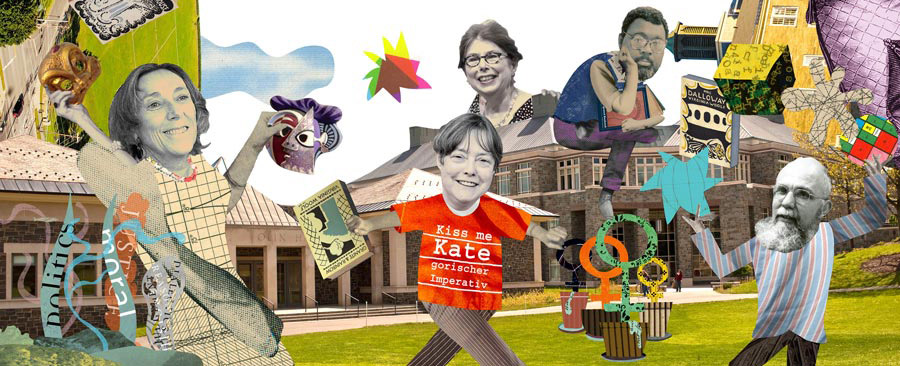![]() As far as anyone can tell, this year marks the largest group of professors ever to retire from Colgate — a venerable dozen representing 4 percent of the full-time faculty. With a collective 391 years as teachers and scholars, they have also been leaders in their fields, and have helped shape the university itself.
As far as anyone can tell, this year marks the largest group of professors ever to retire from Colgate — a venerable dozen representing 4 percent of the full-time faculty. With a collective 391 years as teachers and scholars, they have also been leaders in their fields, and have helped shape the university itself.
To acknowledge this significant passage, we asked these esteemed — and vibrant — Colgate personalities to share some thoughts.
They reflected on their proudest moments, lessons learned, teaching philosophies, and scholarly passions, and looked to the future. Our hope is to evoke on these pages a sense of their impact — of the knowledge and understanding they have given thousands of individuals, on this place, and on the greater world.
By Rebecca Downing / Illustration: Oliver Weiss
John Knecht | Nancy Pruitt | Margaret Darby | Phillip Richards | Michael Johnston | Maudemarie Clark | Antia Johnson | Paul Pinet | Ulla Grapard | Bernadette Lintz | Joseph Wagner | Jane Pinchin
John Knecht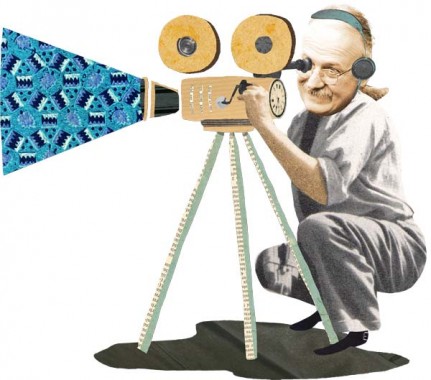
Film and Media Studies / 34 years
My favorite course: History and Theory of Cinema introduced students to motion pictures from the 19th century to the second half of the 20th. We began with the origination of the lens, the camera obscura, the magic lantern, and photography. I placed films within the context of the social, artistic, and political atmosphere of the time and place of origin. The students were confronted with the fact that “cinema” is an art form that demands rigorous intellectual engagement. We wrestled with theory from the earliest writings to issues of psychoanalysis, Semiotics, Marx, queer theory, issues of reception, and race. Many students told me the experience changed their lives. It allowed me to channel my passions.
My proudest moment: The privilege of working on the creation of Little Hall. I had the job of convincing the administration and Board of Trustees that this was an important undertaking. I helped raise funds. Never once did I hear “no.” The faculty designed the studios and classrooms; we worked with the architects. I made friends with engineers, contractors, and guys pushing wheelbarrows full of cement on cold winter days. The design concept: a neutral place for making, exhibiting, and projecting images of art, to support the teaching of studio art and art history.
Changes in the “tools of my trade”: When I first started at the University of Oklahoma in 1974, my students would spend $2,500 to end up with 10 minutes of projectable 16mm film. Color video cameras were as big as small cars. Sound was recorded on a reel-to-reel tape recorder and transferred by a commercial lab. When I came to Colgate, students did animation with a 1936 Kodak film camera, and worked in super 8mm. In 1985, we integrated a Commodore Amiga into production and post-production. These were some of the first art courses to use digital tools at Colgate. Other schools used us as a model. Now everything is made in a digital format.
On teaching: Students usually entered my classes thinking they already knew what movies were. They had grown up in front of the TV and went regularly to movies at the mall. My challenge was to convert them from being satisfied by the shallow pleasure of being entertained by a narrative based on theatrical empathy, to an experience that demanded critical thinking about larger issues intersecting with a consideration of the formal aspects of the medium. I knew that when they left my class and went out into the familiar culture of the day, they would be snapped right back to the center, as a rubber band relaxes after being stretched. But I would sleep better at night knowing that they had been out there on the edge.
If my scholarly career were a movie, what would it be called, and who would play me: Monkey Shines III, played by an out-of-focus apparition, shimmering jaggedly in the light of the silver particles projected on the white screen (it would be shot on celluloid film). The frames would be made individually and animated. The many scratches and chemical stains would have as much presence in the frame as the figure dancing in a jerky, unsettling yet beautifully rhythmic sequence. It would be 20 seconds long and dedicated to William K. Dickson, chief motion picture technician in the 19th-century laboratory of Thomas Edison.
Office memorabilia I will keep: A painting of Elvis on velvet and hundreds of student films.
My favorite spot on campus: Little Hall. I plan on haunting it. I will be entertaining. I promise.
What’s next? I am making new work and my gallery exhibition of new “electric paintings,” along with work from the last 20 years, opens at the Massry Gallery at the College of St. Rose in January 2016. I am on the board of several nonprofits and continue to work with the New York State Council on the Arts. I need to keep my collection of old Fords running; and have plans to start a new rock and roll band when I turn 70, which is fast approaching.
Nancy Pruitt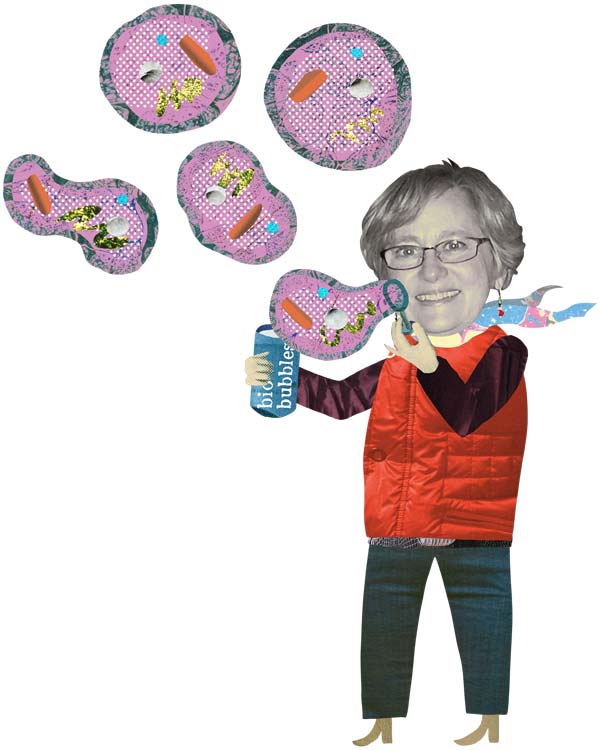
Biology / 32 years
My favorite course to teach: Biology for non-majors. It was less important to delve into the nitty-gritty details, freeing time to indulge in the myriad exciting aspects of the field. I used to call it “all dessert, no vegetables” teaching.
Something I always told students: Because biological phenomena often occur on surfaces (e.g., cell membranes, epidermis, cuticle of animals and plants, or even surfaces on the Earth), I used to tell my classes that if they were completely stumped by a test question, they should simply answer, “This helps to increase the surface area,” regardless of what the question actually asked. In about half the cases, this would get the student at least partial credit. Of course, I ended up receiving this answer on MANY of my test questions — even if the question had nothing to do with surfaces!
If my scholarly life were a movie, it would be called: Life on the Edge (because I am interested in biological phenomena in extreme conditions).
What I’ve learned from students: Know when to take crazy risks in research; but be sure to have a “plan B.” I had a few students who pursued research projects that, on their face, seemed unlikely to yield anything. Most of them did not pan out, but the ones that did were tremendously successful. Some even steered the direction of my research for years.
Office memorabilia I will save: Several of my international students brought me trinkets from their home countries. I value these items, and think of my students each time I look at them.
Changes in the “tools of my trade”: The tools of the biologist have undergone unprecedented change in the past 30 years. I started my career studying the properties of proteins; now we go right to the genes that encode those proteins.
My favorite spot on campus: I love the trails above the old ski hill. They are great for skiing in the winter and hiking in the summer. Sometimes I go there just to clear my head.
My proudest moment: The day I got tenure. I felt free to take bigger risks in both my teaching and my research.
What’s next? I am already enjoying time with my family and friends, to a degree I was not able to while working. In the fall, I have plans to work with a community-based organization in Washington, D.C., which helps students from underserved communities get into and succeed at elite colleges.
Margaret Darby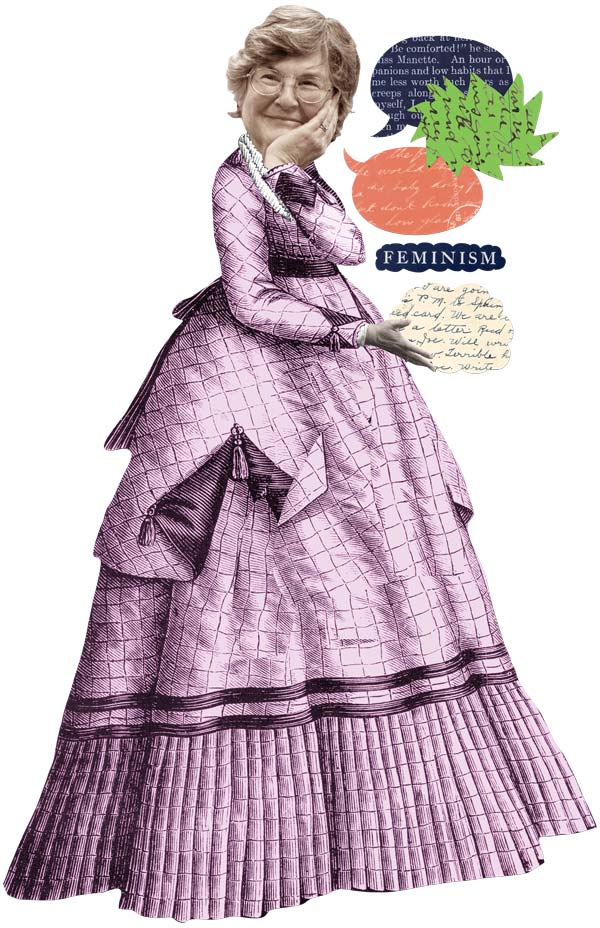
Writing and Rhetoric / 29 years
My favorite courses: The course that exemplified my favorite methods was Introduction to Writing in the Humanities/Writers and Readers. In some ways, it used ordinary best practices in composition and rhetoric, but in others it was unique to my pedagogical philosophy. The students usually wrote personal memoir, so I got to learn a lot about their own lives, especially their families and experiences before college. Because we spent so much time with rough drafts in class, they got to know each other in a special way as well. They had to be willing to expose themselves linguistically, and they always treated each other’s writing with great respect.
Oft-taught principles: In Language and Gender, all semester, we explored the implication that words mean what a community of speakers means by them, going way beyond what any individual speaker intends; and, that all language is radically context dependent.
Memorabilia I will save: The picture of the 1993 Manchester Study Group participants raising their glasses in a pub in Wales that the students had framed to give me.
Biggest change in the “tools of my trade”: Unquestionably, access to the bottomless pit of the Internet, which I believe makes it harder to learn to think than it was for me when I was a student.
My favorite spot on campus: I like to survey the trees and shrubs.
Alumni relations: Former women students of Language and Gender have shared with me their decision to take their husbands name in marriage, or not. I have also heard about changing pronoun usage — always full of political implications.
I’m most proud of: Students credited me with creating a particular atmosphere of listening and sharing ideas that did not have to be “defended.” I have never learned well in an attack/defend atmosphere, and so I never wanted that kind of contest in my classroom. I wanted my students to consider opposing ideas together, building interpretations and conclusions without forcing anyone to stand by them.
What’s next? Teaching always took priority, and I accepted that for nearly half a century of careful attentiveness. I am ready to give priority to other things in retirement, but I expect to keep my Colgate e-mail address for the rest of my life, and I will always want to know how my former students and colleagues are doing.
Phillip Richards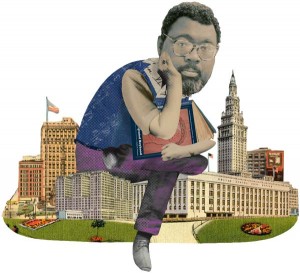
English / 28 years
My favorite course to teach: My 400-level course in the novels of Henry James. We are living in another Gilded Age of enormous wealth at the top of the society; a careless, spoiled leisure class; and oppressed laborers. My senior English majors took to James’s descriptions of the manners, psychology, and habits of the rich (and would-be rich) like fish to water. In Washington Square, a cad is wooing a wealthy doctor’s daughter. When the father is away, the cad comes into the house and smokes the father’s cigars and lounges on his chairs. I remember a student said that this cad was used to sponging off of rich people because he didn’t notice the servants and maids who must have been moving about the room. I thought that was one of the most acute observations of social life that I had ever heard.
A classroom ritual: I began, at some point, reading a chapter of my autobiography, An Integrated Boyhood: Coming of Age in White Cleveland, for the final class. The event became a ritual, and my classes began to ask for a chapter before the end of the semester.
What I’ve learned: The importance of persistence, from students and colleagues who, over the years, struggled until they met and surpassed their goals. They are outsiders to this world who, all the same, succeed in it. They do it by working hard and keeping their heads down. They often have trouble at first, but as they move on, they rise to the occasion. The longer I was here, the more attention I paid to the kids who had a couple of courses with me and who were doing better in their junior and senior year than when I had them as first-years. Some people thrive on a kind of challenge that being an outsider presents.
On scholarship: Colgate has been very kind to me, generous, and sympathetic. I could never have traveled and done research without Colgate’s funding. That’s been an important part of my life here.
Recent extracurricular activity: In 2013, I began editing an international arts journal, DoveTales, published by Writing for Peace. As I wrote in the first edition’s introduction, the awakening to both politics and art demands the alert observer’s discriminating judgment of power and beauty. Literature and art seek a renewal of spirit as surely as they make an equally urgent contemporary demand on our cultural and political attention.
I’m most proud of: Gaining tenure and being promoted to the rank of associate professor
Best advice I ever received here: Just before I received tenure, George Henry, a black West Indian economist — an accomplished man who had written a number of books — told me in his fatherly way that I would be exceptionally lonely in the Chenango Valley; however, out on the fringes of Colgate life, I would nevertheless find congenial companions.
What’s next? I would like to continue reading, writing, and thinking, perhaps traveling more than I have been able to in the past.
Michael Johnston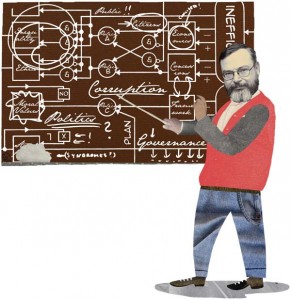
Political Science / 29 years
Most satisfying class to teach: Political Science 313: Political Corruption, which is related to my research, writing, and policy work
Teaching moments: I put a strong emphasis on writing. I told my students three things: First, the best way to become a good writer is to read good stuff. Second, they are not really writing until they are rewriting. You have to rip stuff out, rearrange, rewrite. Third, writing is a conversation with oneself. What am I arguing? Do I make this point well? Writing is not the output or outcome of the scholarly process — it’s the process.
My classic assignment: I’ve got an imaginary country I call Malgovernado. Depending on the class, I challenge students to come up with a democratization strategy or an anti-corruption plan. I throw in a variety of details, some of which are relevant and many of which are meant to fog the issue. When I make it optional, students never do it. But when I make it compulsory, I get some decent answers. I’ve used it off and on for 40 years.
I’m most proud of: I was recognized with the Grawemeyer Award for Ideas Improving World Order. One thing I have tried to do over 40 years is to get the anti-corruption thing better established within my discipline, and that was maybe evidence that a whole bunch of us who’ve been working on that have succeeded. It was nice to be recognized, and I hope the book (Syndromes of Corruption) and the award have brought attention to the people around the world who are opposing corruption at great risk.
Changes in “tools of my trade”: In terms of the technological revolution, I am not entirely persuaded it’s all to the good. Too many students and their enablers believe that research is “retrieving information.” It encourages short attention spans and intellectual passivity. There are good things as well: you can assemble a data set in an afternoon that would have taken a month’s work otherwise.
I don’t see what’s wrong with the old chalk-and-talk model. Boundaries are essential. My approach more closely resembled a doctor-patient relationship than Mr. Chips.
What’s next? We’re moving to Buda, just outside of Austin. Our younger son, his wife, and their two boys are there. My wife is a Texas grad, both sides of her family are Texan, and half of mine is, so it seems like a place to live well and relatively inexpensively, in a community with an academic presence.
I’m writing a book called Corruption, Inequality, and the American Dream. The notion is that inequality problems have a lot more to do with corruption than we think, and that they take their toll at the level of things people think they’ve been promised in this society — not that they can have a house and a car, but that they’ve been promised fair treatment, a voice, the right to be taken seriously. Focusing on America is a change for me. My work has had more to do with the international arena, so I’m kind of bringing it home. Watch your favorite newsstand in 2017!
Maudemarie Clark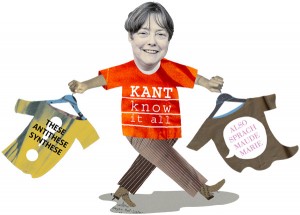
Philosophy / 28 years
What was your favorite course to teach? That is like asking a mother to choose between her children! I’ll give you three: My Nietzsche seminar, Kant and 19th-Century Philosophy, and Core 152: Challenges of Modernity. What I love about teaching is being able to get students to feel and see the aliveness and excitement of thought. Those three courses do that in different ways: Nietzsche by getting deeply into the thinking of one person. With Kant, by showing how four great thinkers thought about the same issues. Core 152 has a broader sweep. It was a lot of fun to teach opera, for example. You could see the students thinking about the material: “So why does he have the gypsy scene here?” (This was Traviata.)
If your scholarly career were a movie, what would it be called, and who’d play you? Will the screenplay emphasize my sense of humor and light touch, or my passion? If the former, it would be called Inventing Nietzsche. If the latter, A Life in Philosophy. It’s gonna have to be Meryl Streep! If she can play Julia Child, she can play me.
My favorite spot on campus: Hascall Hall is a great old building; more specifically, its lounge. I’ve had great conversations in there. My favorite thing about it was in 2007. I was department chair at the time. I came in and graduating women students were having a PJ party. To see them there with their pillows and blankets was great.
I’m most proud of: Various of my students winning fellowships and admission to grad school. Helping to build a terrific philosophy department; they are all great philosophers and really nice people. And, my work on Nietzsche. As Brian Leiter put it, my Maudemarie Clark, continued 1990 book (which basically got me tenure) was the “turning point” in Anglo-American Nietzsche scholarship, due to its combination of “meticulous scholarship” and knowledge of the relevant philosophical issues.
Memorabilia I will save: The cover of the January 1999 Colgate Scene, of Rhodes Scholar Antonio Delgado ’99. I was his thesis adviser. Also, a photo of me teaching outside Alumni Hall from the 1999 calendar. Ellen Myers, our secretary, came into the lounge and said, “Maude’s a pinup girl!”
And, my copy of Schopenhauer’s World as Will and Representation signed by members of the 1990 Colgate hockey team that went to the NCAA finals. I was teaching it in my Kant class and one of the students got me the autographs. My partner, Connie Jones, and I went to every home game that year and followed the team to Detroit, where they played the University of Wisconsin. I received my PhD there — it was the only time I’ve ever cheered against UW.
What’s next? I will continue to teach half-time at the University of California-Riverside. I have at least three more books to write: the Nietzsche book for the Rutledge series “The Philosophers”; a book on Nietzsche and Morality (my dissertation topic); and, David Dudrick (philosophy) and I wrote a book on the first part of Beyond Good and Evil — I want to do the rest of it. I will also be working on translations of that and The Gay Science with Alan Swenson (German).
I’ll still be in Hamilton for the summers and falls for at least three more years — Connie and I have been partners for 38 years, married for almost 4. She worked at Colgate’s Counseling Center for 11 years and is now at Bassett (in Cooperstown).
Anita Johnson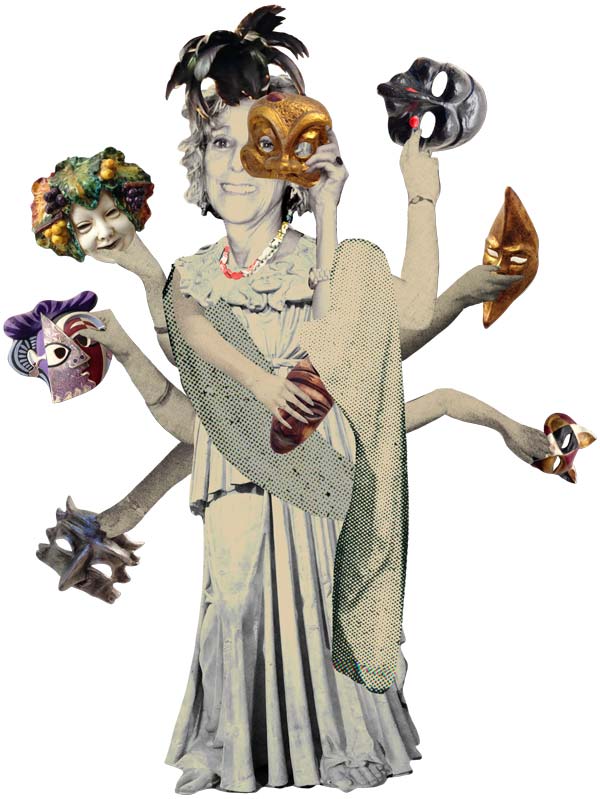
Romance Languages and Literatures / 28 years
My favorite course: I was delighted to teach my Contemporary Spanish Theater seminar. I gave an intense historical background about the Spanish Civil War, so they could understand how the arts and literature suffered during 40 years of dictatorship. I’d bring in taped interviews with Spanish playwrights. I also invited playwrights from Spain to come, including the best playwright of the postwar years, Alfonso Sastre, in 1989. I also loved teaching Core 151: The Greeks. I love Antigone; it’s the tragedy I’ve taught most of the time. We also read The Odyssey, the quintessential metaphor for the journey.
On teaching: I always tell my language students, lose your inhibitions. Everybody has to struggle; you will all experience embarrassment at some juncture, so get over yourselves! I was always pretty funny in my classes. I would say something outrageous. There would be this pause, and then a student would say, “Are you serious, Professor Johnson?” I’d say, “Good for you! You understood.”
My favorite classroom exercise: I’d give them one minute to think, and then we’d go around and everybody had to add one thing to compose a tale. As they were speaking, I’d write it on the board. That impromptu use of Spanish used to be the funniest source of entertainment.
Off-campus experience: My second year at Colgate, I was the first person in the department to lead the year-long Madrid Study Group. I had 45 kids — 15 each from Colgate, Vassar, and Wesleyan. I was teaching during the day, writing at night, and taking excursions with the students. I finished my dissertation in Santiago de Compostela the final week of the study group.
Words to live by: I’ve shared with my classes quotes of one of my favorite comics, George Carlin: “Laugh until you gasp for breath.” “The tears happen. Endure. Grieve. And move on.” “Cherish your health. If it is good, preserve it. If it is unstable, improve it. If it’s beyond what you can improve, get help.” “Be alive while you are alive.” That speaks to the way I’ve lived my life.
Keep finding books that speak to you when moments of the void come. Keep asking yourself, what does it mean to be human? This is the great thing about teaching — you get up there and offer sermons!
My favorite place on campus: My office in Lawrence Hall is my academic woman cave; it’s where I’ve done some really good work. And it’s my counseling office — I think my students have found my office very welcoming.
Memorabilia I will save: The masks on my office wall. I’ve always been interested in the Italian Commedia dell’arte, but through the Greek tragedies that I chose to teach, I became enamored of the roots and origins of theater. Students would bring me masks from everywhere: Korea, Brazil, the Dominican Republic, Barcelona, Madrid, Rome, Capri, and Venice. They are all so meaningful.
Extracurricular activities: When I was living in Madrid in 1983, I met the editor of an American journal on Spanish theater, Estreno. I wrote reviews of the theater seasons and then was their book review editor from 1996 until 2006. In 2007, I was put on the editorial board. I was also on the board of Acotaciones, the Royal Academy of Dramatic Art’s journal.
If my life were a movie: I love traveling and meeting people in different cultures, which explains why I adopted my daughter Ling Ling from China. So, it would be a travelogue — of meeting Spanish playwrights, painters, and philosophers; teaching English to Spanish president Adolpho Suarez at his home in the mountains; meeting United Fruit Company workers and the president in Costa Rica; being robbed at knifepoint in Morocco. Cameron Diaz would play me.
What’s next? I am moving back to Boston, where I grew up. I intend to surround myself with what I love: family, pets, keepsakes. And I’m playing with the notion of doing theater myself.
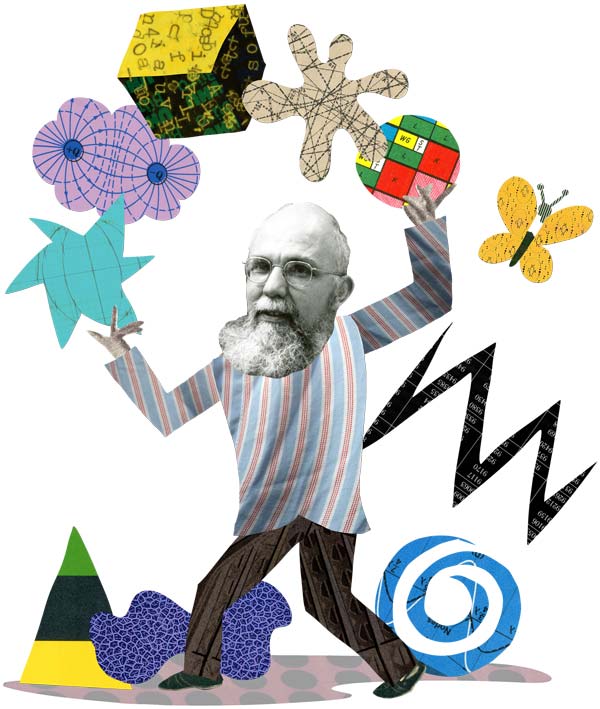 Paul Pinet
Paul Pinet
Geology and Environmental Studies / 37 years
On teaching: I brought in jazz and improvisation. I had a collection of topics. I don’t have A, B, C, D. I begin with A. Depending on a response, I might go to G, H, or J. It keeps the class engaged. Depending on what they ask, I build on it, and they build on what I have been saying. I had the opportunity to develop Ecology, Ethics, and Wilderness, a CORE Scientific Perspectives course that took up moral and social issues. At first, the students didn’t know what to expect. Then it got more comfortable. I really enjoyed it because, just like in jazz, mostly you don’t get to where you want, but what is produced is powerful. I could see the glow in people’s faces. It took all of us to get there.
Words to live — and work — by: With exams and papers, I’d ask them to respond to situations they’d never heard about. Students would say it was unfair. But I’d tell them, when you go to work, real-life problems are complex. They have no specific answers. If your boss asks you to do something, you will have to work it out. That is what I am getting you ready for, no matter what your career.
Memorable moment: I wanted my students to try something different with something they had thought about. These four guys, hockey players, exchanged photos of natural landscapes, and each wrote a poem and worked together to improve them. When it came to giving the reading (it was a big class, about 80 people) they sat in different parts of Olin Hall. They dimmed the lights and started to read their poems. When the lights came on, everyone was crying.
My favorite natural landscape: I went to Antarctica when I was 21. I was dropped off, by a helicopter, for four months, and lived in a tent with another guy. There is nothing living, nothing green. When there’s no wind, there’s no sound. Just ancient rock with all its secrets and this enormous ice sheet. It brings you fundamentally to what’s important on the earth.
On retiring: I’m a Red Sox fan. In 2004, they were in the playoffs. I went to the Colgate Inn because I don’t have a TV. I got totally abused by the Yankees fans. When they went into the World Series, that first game, there were only five people there, all Sox people. We saw all those four games together. When they won, we started to cry. Driving home, I got very depressed — because suddenly they were no longer the Red Sox that I knew. This is what happened to me with retiring. I didn’t expect it. I was happy to retire, but suddenly I got sad. I realized that I am no longer the person I have been all my life.
What’s next? I started watercolor painting natural landscapes six years ago. Also, reading, thinking, hiking, cross-country skiing. And writing about managing barrier islands. Colgate will support the work for five years, which is very generous. And I will teach a course every year.
Ulla Grapard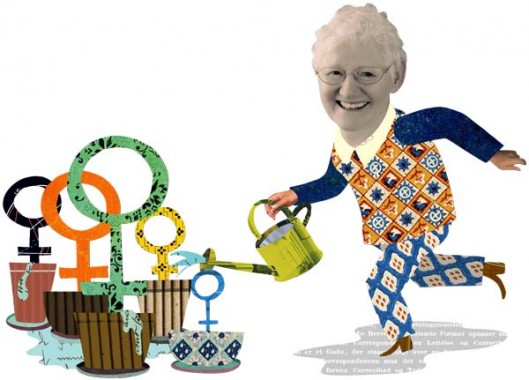
Economics and Women’s Studies / 30 years
My favorite courses: Gender in the Economy, based on my interdisciplinary studies in feminist economics, which pays attention to activities that don’t go through markets, such as caregiving labor — of children, the sick, the elderly. Few students have thought seriously, how do we go about our daily lives, and provide for each other? They gain respect for all the unpaid work being performed that is crucial for the paid world to exist.
My women’s studies course Scandinavian Welfare State: A Gendered Perspective also really matters to me. One of Colgate’s first extended study courses, it has economics, politics, sociology, film, and cultural studies on the syllabus. We’d go to Denmark (where I grew up), for four weeks. I got gender researchers, politicians, and trade union women to talk with my students. We also visited kindergartens, where they would realize that what happens in the classroom is a reflection of democracy in action: how you create the citizens who have high expectations about social policy and democratic governance. Our students loved to see the children play, but would just about have a heart attack because Danish children grow up taking risks. On the playground, slides have no guardrails. Five-year-olds learn to cut with knives. It was extraordinary for them to observe that the children become competent about their limitations.
Extracurricular activity: In the early 1990s, I met up with others to form the International Association for Feminist Economics. When you start a new project and are up against the big guys, you have that pioneer spirit and get to know each other very well. At the conferences each year, I meet up with good friends.
Memorabilia to save: I have a little wooden bowl that a student from Romania gave to me. She came to Denmark the first time I took the class there. There was something about her. One day, I had taken them down to the ocean. It was a warm day, and the beach was deserted. Someone said, “Oh, wouldn’t it be nice to take a swim!” She and I looked at each other, then just stripped down and went into the waves. I think the fact that she was also European was why we were the only two. The others (it was all women) were standing there laughing to see their teacher do something so completely crazy!
My favorite spot on campus: The Center for Women’s Studies. I was director for four years. It attracts a very interesting group of students. They often have more diverse backgrounds than the students I would meet in my economics classes.
Most satisfying: The human relations, the friendships that develop with colleagues across the university. And my involvement with women’s studies has been very important both professionally and personally. I was happy when I was directing it and able to get young women faculty involved.
What’s next? I have living in my house my 4-year-old grandson, Jacob. I am looking forward to spending more time with him. I have all these books I haven’t gotten to read. And there are things I’d like to write about — issues of immigration into Western Europe, in Scandinavian countries as well as the rest.
Bernadette Lintz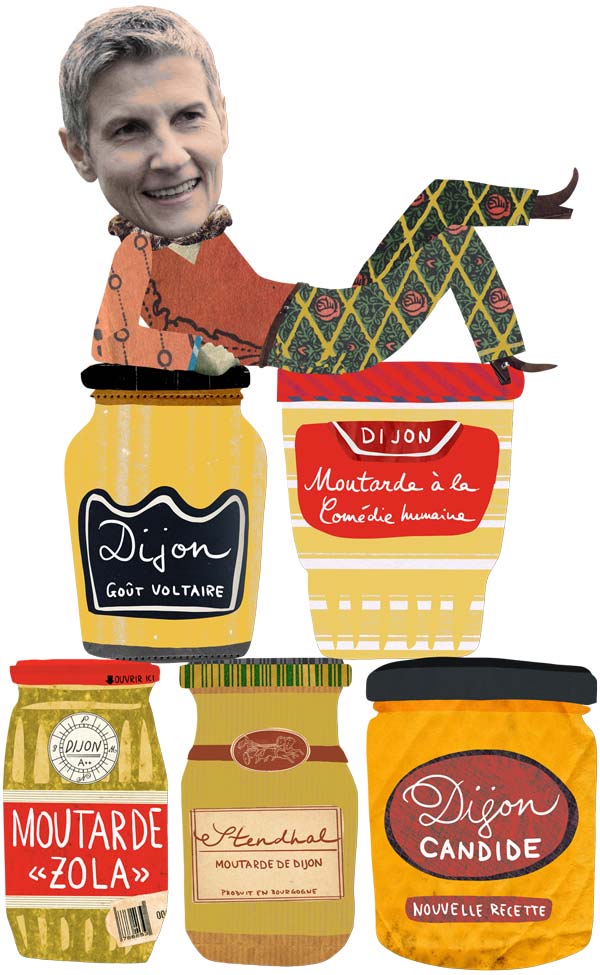
Romance Languages and Literatures / 32 years
My favorite courses: I love teaching advanced French grammar and composition. I love explaining the subtleties and beauty of the language. Of my literature courses, I have most enjoyed my seminar on the Romantic period novel. Over the years I enhanced the content of the course. When I recently taught it in Dijon, I focused on the role of monuments and space in the construction of meaning, since the students visit Notre Dame and other Parisian places featured in the texts. There is so much nuance in those great novels by Hugo, Stendhal, and Balzac, and they are still relevant to the issues confronting every young person.
Planting a seed: In Alsace (where I am from), there is a strong cultural value attached to work and diligence. The household garden was a place of work and practical rewards. So an adage I’ve conveyed in my teaching might be: give all your activities the care you would give your garden! I often ask my students to ponder this when we study Candide. In a way, this is what Voltaire meant when he advised his characters to cultivate their garden; work is a crucial ingredient in solving life’s challenges.
If your scholarly life were a movie, what would it be titled, and who would play you? Deciphering the Deviant (fallen women, corrupt dandies, rotten emperors) — Helen Mirren (as DCI Jane Tennison)
What I’ve learned: I’ve had several students who have overcome adversity — loss of a parent or friend, serious illness, financial difficulties. I’ve often been impressed by the resourcefulness and courage that young people are able to summon. Coming to see this capacity for growth has been an important insight.
Memorabilia I will save: The three torch medals given to me by seniors in French in 2014
Changes in the “tools of my trade”: When I started, it was notebooks, pencils, and the library. Now, teaching tools like Moodle and Blackboard are an important part of my pedagogy, and fantastic digital images can be projected from my iPad. These technologies have made the classroom a much-more engaging place for learning and discussion.
My favorite campus spot: I have many happy memories of the chapel — concerts, convocations, award ceremonies — the rituals that structure academic life on a campus like Colgate, and that I find uplifting.
Study group staying power: The Dijon Study Group has been an important part of my life. Directing a study group is intense — you are professor, dean, administrator, travel guide, and confidante for the students. I’ve done it seven times since 1986. I still get news from students from my first group, and I’ve attended two weddings of former students.
I’m most proud of: I take much satisfaction in seeing my students develop into multifaceted, responsible adults who have the skills to make a major contribution to their professions and our society. And one small part of those contributions traces back to sensibilities they have gained from their careful readings of novels like Le Rouge et le Noir or their study of the significance of the plus-que-parfait!
What’s next? I will continue to do what I love best — reading, reflecting, writing, listening to French podcasts. I have a project underway on Victor Hugo’s writings on revolutionary violence, and several other research ideas. I am also intrigued at the idea of doing cultural writing having to do with the area of Alsace. It is steeped in history, the site of many battles and trauma, and there are stories to be told. I’ll also have more time for fun! I am moving to Dearborn, Mich., where my husband, Dan, lives. So there is much to look forward to.
Joseph Wagner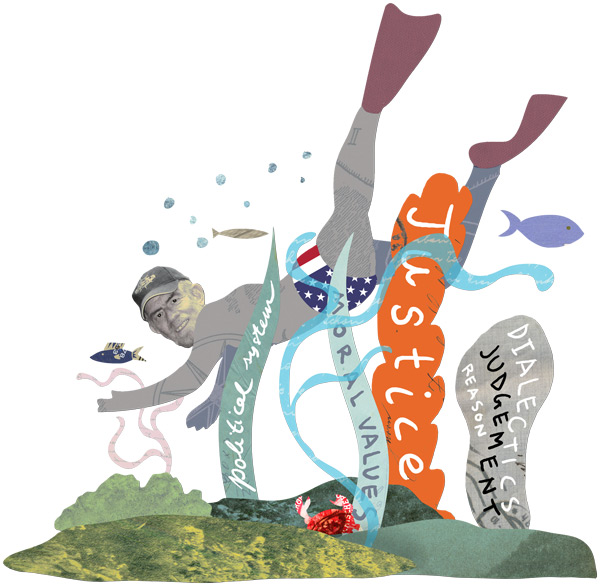
Political Science / 38 years
My favorite courses: Foundations of Political Thought and my Contemporary Theories of Justice seminar. Both are richly and deeply conceptual and counterintuitive. When I came to Colgate, besides being interested in politics and history, I had a strong interest in physics. Beginning in the mid-’80s there was exciting stuff coming out in neuroscience and paleoanthropology that fit well with the themes I was interested in. Several of my courses had a large political psychology component.
My classic assignment: It starts with something conceptual — matters involving justice, morality, the contrast between reason and feelings. The assignment is to build an argument where you write one paragraph giving the reasons and arguments for one side, and in the next you have to criticize the point you have made in the preceding paragraph, so you get to some deeper truth or understanding. Maybe 25 years ago, one student warned the rest of the class: this is the kind of paper that makes you bleed from your ears.
Changes in “tools of my trade”: The ability to talk about thinking in terms of the way different parts of the brain operate. One of the most interesting things to come out in the last 25 years is the understanding of dual processing. We share very old parts of our brain with all living animals that respond to things in the environment before we are visually aware, in sometimes a quarter of a second. But without much-newer parts of the human brain that make it possible to conceptualize all objects in the world, there would be no objects for us. Most students have difficulty grasping that. I often tell the story about S.B. Weathers, who, climbing Mount Everest, was caught in an avalanche and got severe frostbite. They replaced his nose, twisting a piece of skin from his forehead over the cartilage. It grew into a normal nose, but every time his nose itched, he scratched his forehead. I love things like that, because it provokes students to think differently.
My proudest moment: I have had the extraordinary good fortune of having a student who won the Marshall Fellowship, Steve Garvey ’87, and another, Antonio Delgado ’99, who won the Rhodes. And I’ve been adviser to three valedictorians: Steve, Michele Alexandre ’96, and Katie Schmidt ’01.
Unusual contribution: In 1986–87, I wrote a significant piece of software to keep track of affirmative action at Colgate. And I taught the first course ever for faculty on desktop computing. Those are kind of odd, because I am a philosopher in some ways, but I like puzzle solving.
Cat in a former life? I have a perverse pride in having had seven near-death experiences. Several have to do with Colgate — one very directly. Back in 1980, the faculty who taught in the core used to go to Colgate Camp at Saranac Lake for a workshop. I thought I’d go canoeing to unwind. As the sun came down, the wind came up, and the canoe turned over in 55-degree water. First thing I thought was, my wife was going to be really pissed with me if I die and leave her with two children and a dissertation she had supported for years but never got completed. I grabbed the canoe and decided there was an island I could get to. As soon as I got out, every muscle in my body was shivering. A man came by with his motorboat. His wife scanned the lake every night with a telescope. She saw me in trouble, and sent him out.
What’s next? I’m working on a 350-page manuscript and an article I’m excited about. I want to join a social service group that does political lobbying. I am interested in compassionate choices and am deeply concerned about inequality in this country. I am also being encouraged to start a blog.
Jane Pinchin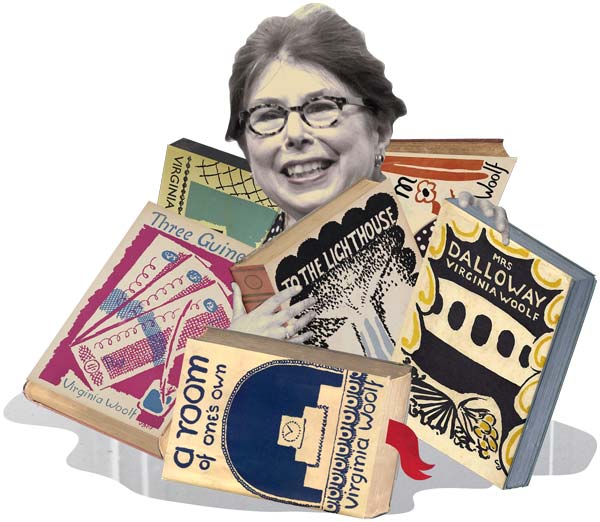
English; Interim President, 2001–2002; Provost and Dean of the Faculty, 1994–2001 / 46 years
My first day: I had just turned 23 when I first entered a Colgate classroom (before returning to Columbia to finish a PhD and teach at Brooklyn College). Manhattan born and bred, I’d learned to drive only months before coming here. My car broke down as I came up the hill; I abandoned it and walked to Lawrence Hall, where I was teaching Core 15, a common syllabus. Topic: Aristotle. One of the students in this all-male class asked the first question: about the Greeks and sexuality, so clearly designed to make me uncomfortable. I relaxed instead. Teaching would be a great pleasure from here on.
My favorite course: Ah, so many candidates here: study group courses where England was one’s lab; courses in the core, seminars (Wallace Stevens, the Brontës, Woolf, and Forster). But best actually came last: Living Writers with Jennifer Brice. In five years we never taught the same text twice. The joy of team-teaching with Jennifer, and of engaging with the likes of Jennifer Egan, Junot Diaz, Salman Rushdie, V.S. Naipaul, Chimamanda Ngozi Adichie, Jonathan Franzen, and with alumni as well as with students. What a privilege.
The most important thing I learned from students: How hard it is to be different from those you consider the norm. When I first taught here, a young man who is gay spoke of what he felt he then had to keep secret. Others — poorer, from upstate, or racially “different” — have worked through what it is to redefine the center at Colgate. I learned about bravery.
Changes in the “tools of my trade”: Ours is a time in which teachers can present students with materials at our, and their, fingertips. In which we can teach in conversation with one another, as in Living Writers where we had 60 students on campus as well as 800 alumni and friends, using video interviews, live-streaming, blogs, and text. But we are left with some important questions: What are the consequences in the new emphasis on technology for the future of liberal arts colleges? Are there consequences for the values of contemplation, for time and space to think and create and read? When Coleman Brown (who died this year) retired in 1996, he wrote for the Scene about the issues that had shaped his vision, on the meaning of a life worth living. About the gifts of education, action, and contemplation. Coleman used only pen and ink and wonderment.
Memorabilia I will save: I love the book jackets Virginia Woolf’s sister, Vanessa Bell, designed, copies of which hang on the walls of my office. But the one piece of memorabilia I cherish most is the framed introduction to the Alumni Corporation Humanitarian Award: begun in 2003 in my honor, and each year honoring someone with a “devotion to community.” It brings me joy.
What’s next? First, I want to take some time to consider seriously what’s next. But there are certainly some things on my plate now. I have a book on E.M. Forster and Bloomsbury to finish. A two-year-old grandchild, and another on the way in September: the most extraordinary life-changing pleasures. A husband aching for travel. And I serve on the Bowdoin College Board of Trustees and the board of our local hospital.
The constant that is Colgate: I’ve had a lot of jobs at Colgate — directing two academic divisions, working as provost/dean, interim president, as a VP for academic advancement, as acting head of the Picker Art Gallery, and, finally, as chair of the English department. I’ve seen a curriculum grow, and Colgate’s ambitions expand in every corner. And I’ve noted, of course, how much coeducation and diversity have changed the place. But to do justice to that topic — and to examine what is needed for the completion of a project, begun here and elsewhere at liberal arts colleges in the ’60s and ’70s — requires extensive and serious talk. That change is still an important work in progress.
The constant is a loyalty, deep and sincere. Students leave here surrounded by the spirit of place and in love with an institution that has won their minds and hearts. Why? Perhaps because of the beauty of the space, but more likely because of a superb faculty and staff that daily give their all. It would be hard to overestimate the quality of Colgate’s faculty — teacher/scholar/citizens of note: pedagogical innovators, doing internationally respected research, and claiming their place as stakeholders in this institution. You could not be taught better anywhere. Full stop.
